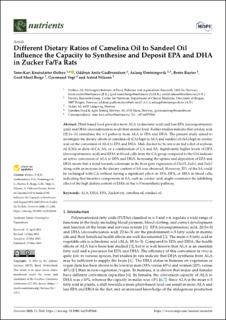Different Dietary Ratios of Camelina Oil to Sandeel Oil Influence the Capacity to Synthesise and Deposit EPA and DHA in Zucker Fa/Fa Rats
Østbye, Tone-Kari K; Gudbrandsen, Oddrun Anita; Drotningsvik, Aslaug; Ruyter, Bente Synnøve; Berge, Gerd Marit; Vogt, Kjell Gjermund; Nilsson, Astrid
Journal article, Peer reviewed
Published version

View/
Date
2023-05-17Metadata
Show full item recordCollections
- Department of Clinical Medicine [2066]
- Registrations from Cristin [9791]
Abstract
Plant-based food provides more ALA (α-linolenic acid) and less EPA (eicosapentaenoic acid) and DHA (docosahexanoic acid) than marine food. Earlier studies indicate that cetoleic acid (22:1n-11) stimulates the n-3 pathway from ALA to EPA and DHA. The present study aimed to investigate the dietary effects of camelina oil (CA) high in ALA and sandeel oil (SA) high in cetoleic acid on the conversion of ALA to EPA and DHA. Male Zucker fa/fa rats were fed a diet of soybean oil (Ctrl) or diets of CA, SA, or a combination of CA and SA. Significantly higher levels of DPA (docosapentaenoic acid) and DHA in blood cells from the CA group compared to the Ctrl indicate an active conversion of ALA to DPA and DHA. Increasing the uptake and deposition of EPA and DHA meant that a trend towards a decrease in the liver gene expression of Elovl5, Fads1, and Fads2 along with an increase in the dietary content of SA was observed. However, 25% of the SA could be exchanged with CA without having a significant effect on EPA, DPA, or DHA in blood cells, indicating that bioactive components in SA, such as cetoleic acid, might counteract the inhibiting effect of the high dietary content of DHA on the n-3 biosynthetic pathway.
